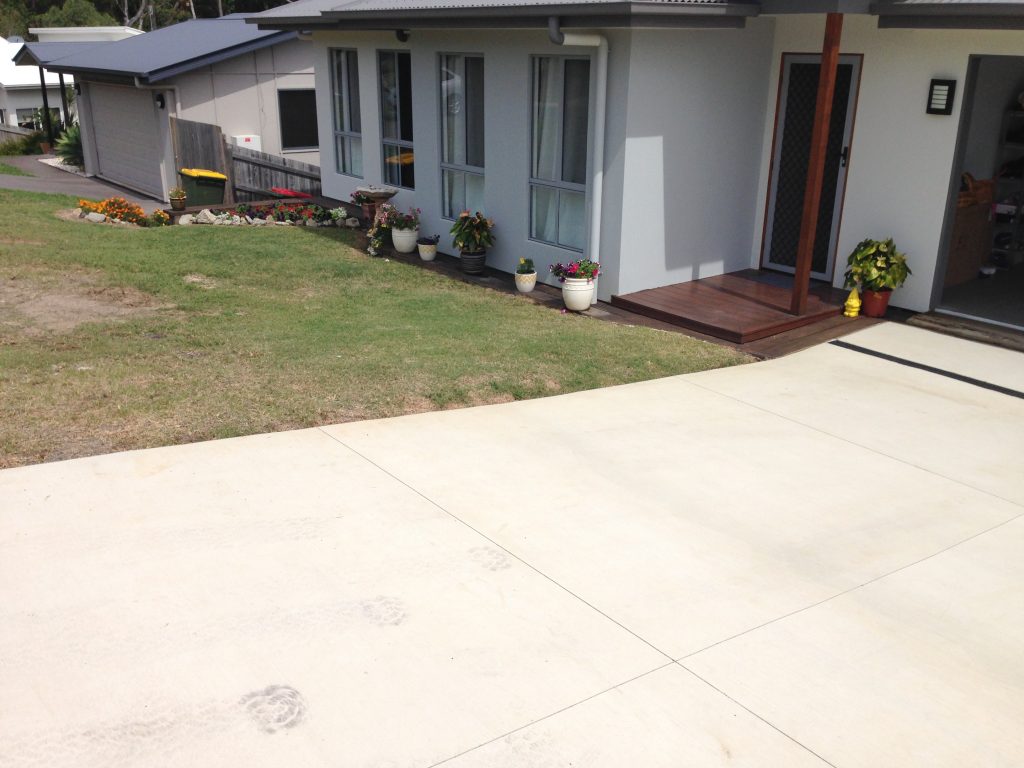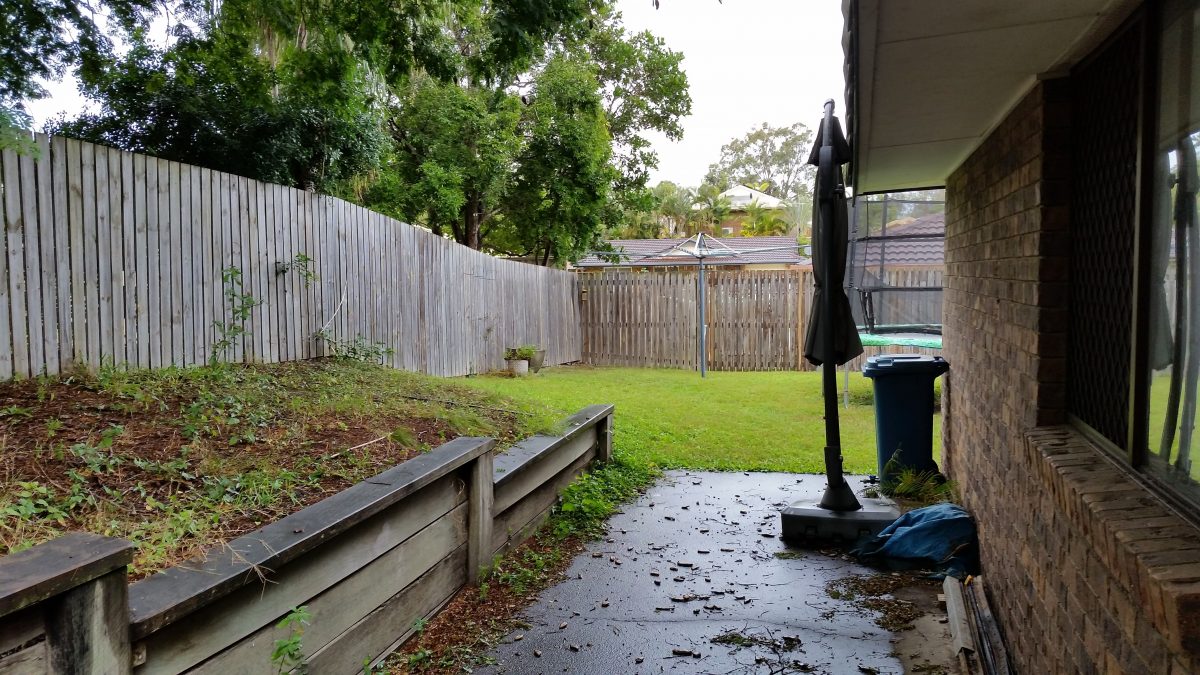Have you got a house on a sloping block with drainage problems?
The queries we get go something like this:
Hi. My house is on a sloping site (slopes from the back towards the front) and water gets in under our house when it rains. The ground under our house gets wet and then takes ages to dry out. Sometimes the water gets into the downstairs rumpus room, storeroom, laundry, garage slab (pick one or two!).
How can I stop water getting under my house? Should I use an ag pipe and or should I install a better drain?
Well, we have some ideas (and a video) that might just help.
This is an amazingly common question so let me show you what steps you should take to try and fix the drainage issue before you call in the experts and start spending the big money.
Fixing Drainage Problems for Houses on Sloping Sites – The Video
If you would rather read than watch, then Head over to this page for captions from the video.
Where Does the Water Come From?
This bit of investigation is going to have to happen when it rains. So get your gumboots, raincoat, umbrella, or rain poncho out and wait for the rain.
These are the things (in order of importance) that we look for when solving drainage problems for houses on sloping blocks.
Roof gutters
- Do your gutters overflow?
- Do you have enough downpipes?
- Are your gutters full of leaf litter?
When you run a hose in your gutter does the water come out of a pipe somewhere downstream of your house?
Keep your gutters clean and well maintained. Water landing on your roof should discharge via downpipes into the in-ground pipes and end up downstream of your house.
Add extra downpipes if you have to or upgrade the size of your gutter.
I don’t care (structurally) whether the water then crosses the footpath or flows down a hill.
Getting the water downstream of your house is priority number one.
Complying with the drainage rules is something to discuss with your plumber and council.
Overland flow from your neighbour
If you are downslope from your neighbour’s property and their water runs toward your house – you have to do something to capture that water before it gets right up close to your house.
- Divert it with swales.
- Catch it with spoon drains.
- Direct it with retaining walls.
You can’t let this overland flow water get near your house.
If you are unfortunate enough to be in the overland flow path and are taking water from the council road or street then your problems are even wetter and slightly harder to solve. You are going to need to speak to the council about diverting water away from your property.
For smaller flows, handle the overland flow with surface drainage solutions like spoon drains rather than in-ground solutions like ag drains and cut-off trenches.
Side note: Check out our Youtube video on spoon drains!
Gravel-filled trenches are only for capturing water that is already in the ground!!
Capture the surface water at surface level, divert it around your house and discharge it on the downslope side of your house.
Underground flow from your neighbour
This is becoming a thing on smaller blocks.
You can’t control what is happening uphill from your house so you have to identify this issue and capture this water before it affects your house.
Now, this is the purpose of ag-drains and gravel-filled trenches. Capture this in-ground water and discharge it downstream of your house.
Rainwater that lands on the ground near your house
Current standard AS2870 requires good drainage around modern houses.
This is drainage AWAY from the house on all sides – even the upslope side.

Older houses need this drainage love too.
Now, this is the trick – the clayey ground surface under the sandy, loamy surface is the ground that has to grade away from the building.
Have you ever poured a bucket of water onto the sand at the beach? The water soaks in a disappears. If you have gravel or sand or pavers or any other porous ground covering around your house, it is the CLAYEY soil under the gravel or whatever that has to fall away from the building.
The water soaks straight through the sand, rock, pavers. it has to be drained away from the building by the clayey soil underneath.
Rainwater that lands on concrete slabs around the outside of your house
I’m not saying that concreters are lazy – just that the sand they place under concrete slabs is the IDEAL way to pour water against and under your house slab if the clayey soil under the concrete and sand falls towards the house.
The clayey soil (under the sand) must fall away from the house.
Yes, it is necessary for the concrete slab to drain away from the house but isn’t it wasted if that water drips off the edge of the concrete and drains sight-unseen back towards the house?
Slope the clayey soil under concrete slabs away from your house.
Ag pipes on the upslope side of the house
A poorly laid ag pipe can wreck your house so easily.
The ag trench has to be installed well. It has to be free-draining and it has to discharge downstream of your house.
Now, do you see why it is so important to install ag-pipes properly?
How can you tell after the ag-drain has been installed that it is causing drainage problems? You can’t – until it becomes a source of moisture beside and under your house.
- Use ag pipes to capture in groundwater and not surface water.
- Slope the trenches in the direction of the water flow and discharge the ag pipe downstream of your house.
Rainwater Bubblers
Rainwater bubblers are field inlet pits used to distribute water from the roof – like a field inlet pit in reverse I guess.
We only use them downstream of a house because they can cause water to flood back under a house and become a problem if installed in the wrong location.
Keep an eye out for rainwater bubblers (or field inlet pits that flow nowhere) and make sure if they have been used that the water coming out of them flows away from your house.
Sewerage Trenches and Stormwater Trenches
Now I’m not saying plumbers are lazy, BUT, when plumbers backfill plumbing trenches with sand and pea gravel that backfill material is porous.
Water can run on the outside of the pipes through your trench and in under your house if the base of the trench is graded back towards and under your house.
It’s really hard to spot these drainage nightmares so I am imploring plumbers to start taking care. Please slope the bottom of your trenches away from houses. Please think about using a clay plug to prevent water from flowing back under the building.
Plumbers should all be aware of what a clay plug in a pipe trench is. It is a 400mm length of damp clay tamped (compressed) into a trench around the pipe to stop water backflowing through a trench and under a house.
Don’t know where to find some clay?
The clay comes from “somewhere else” on the site if it is a clayey site. I’d prefer it was pinched from somewhere downstream of the house but it could just as easily be some of the spoil from when the trench was dug.
If you have water flooding under your house and there are pipe trenches in the area, think about whether water is flooding under your home via the plumbing trenches.
Broken Pipes and Drainage Problems
Initially, I didn’t include this in my list of water sources for flooding under a house but, let’s face it, if water is entering under your house because of broken pipes upstream of your house you don’t necessarily realise unless you’re told.
(Unless it’s a broken sewer pipe and maybe your nose would let you know.)
Check your plumbing pipes if water is flooding under your house. It could just be coming from a broken pipe under or just upstream of your house.
Waterproofing External Walls
If the water is running en masse towards your house as per all those previous points then waterproofing some walls is not going to work.
Waterproofing is the last line of defence and should only be used for the little bit of water after all of the other drainage problems have been solved.
It’s too common for waterproofing to be done badly, not at all or for it to fail prematurely.
A water path under a footing or a full-on gush of overland flow isn’t going to be stopped by excellent waterproofing – well not permanently anyway.
Waterproofing will only stop that little bit of water that is left after good surface drainage, good inground drainage and careful placement and protection of plumbing trenches.
Drying out under a house now becomes a mopping up job
Sometimes a little bit of water may still find its way under your house.
To avoid the area under your house becoming dank, musty, smelly and rotten then a good powered ventilation system might just save your belongings and your marriage.
We don’t design ventilation systems for subfloor areas but with some careful Googling, you’ll find online resources to help you calculate the volume of air that needs to be changed out and a couple of options for fans, ducts, vents, inlets, outlets and timers.
You can get really fancy with subfloor ventilation systems too. Consider whether you really need differential humidity sensors (no!) and timers (yes).
It isn’t the last line of defence – this is just the backup plan for your sanity and it is NOT part of your sub-floor drainage system,
The Last Line of Defence for Drainage Problems
We now come to the very last line of drainage defence.
Ag drains, surface drainage, pits and pumps all located under your house.
The ag-drains should be installed in gravel-filled trenches. The trenches and surface drains all have to slope towards the pit. The water collects in the (deeper) pits and when the level gets high enough a sump pump sends this water into either the stormwater system or sewerage system (depending on the rules for your area).
It’s a system that needs maintenance, power and a lot of love. It is not a system to fully rely on because the BIGGEST storms sometimes come and cause power failures – and electric pumps don’t work so well when the power is off.
The pump and pit need to be sized by a professional – we have sized the pits before but a plumber has to supply and install the pump.
Don’t rely on this system. It is a backup plan only and I only mention it here because we have had to use when all else fails. But I would prefer that all else did not fail.
Now the hard sell!
Drainage Plans for Houses
So far everything we have given you has been for free.
Take that information and do your best to improve your site drainage and keep the area under your house dry and lovely and liveable.
However sometimes you really just want a professionally drawn plan that you can give your landscape gardener, your plumber, your electrician and your roof plumber so that you can solve your sub-floor drainage issues quickly and easily.
We’re here to help.
Introducing our new house drainage design service.
We will attend your property, inspect and identify the drainage problems and issues and provide you with a plan that you can give your tradesfolk. Then at your leisure, you can make the changes that will hopefully restore your site drainage and healthy sleep patterns.

